Taxonomy is the branch of biology that deals with describing, identifying, nomenclature, and classifying plants based on their similarities and differences with other species.
It involves naming and placing organisms in the same group based on their physical characteristics, evolution, and genetics. With this organized system, we can better understand the biodiversity of flora, fauna, and microorganisms.
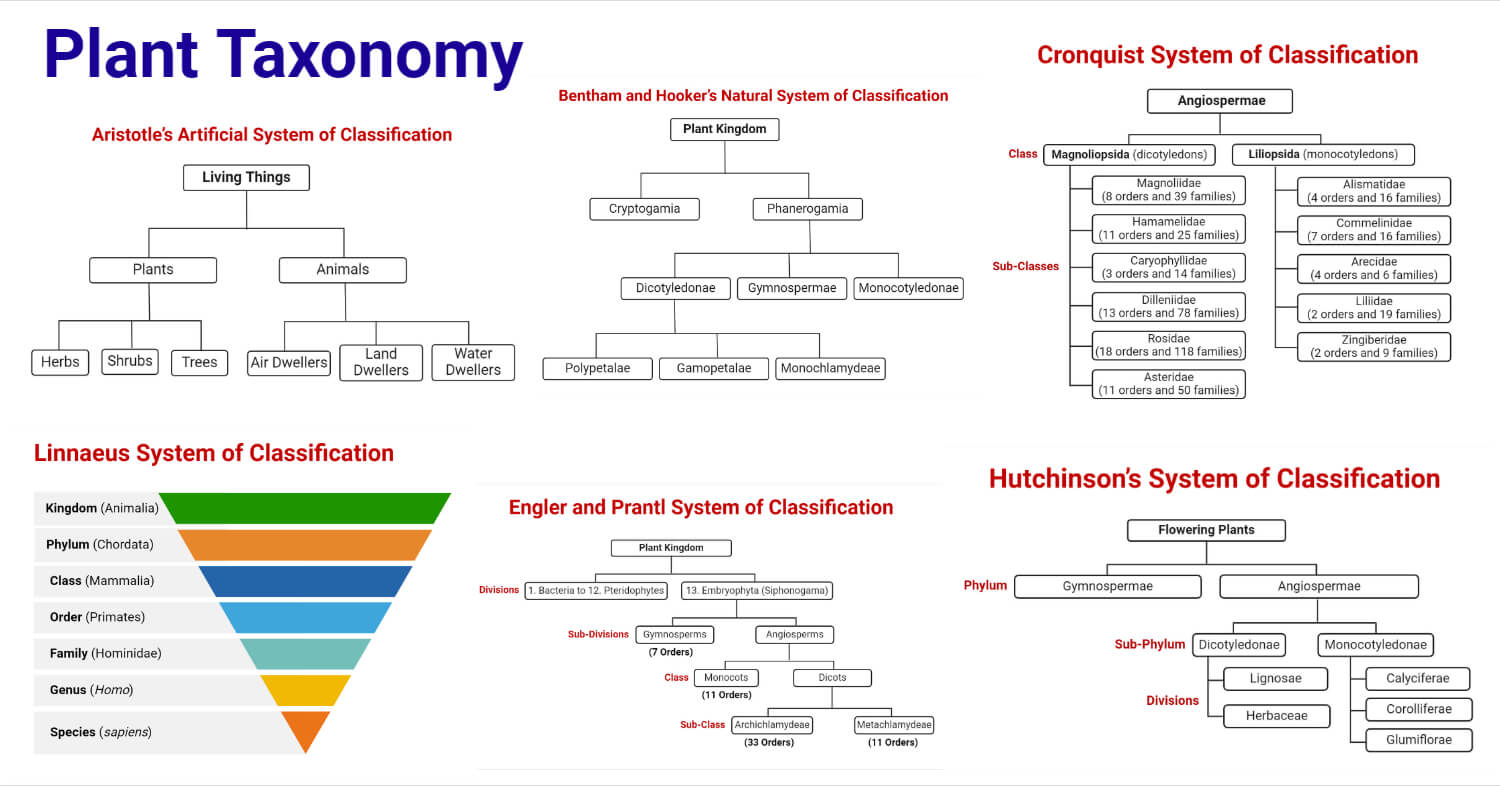
Systematics is the branch of biology that deals with the study of the diversity of life and the relationship among different organisms. It involves classifying organisms based on their evolutionary history, genetic similarities, and shared characteristics.
Systematics is the study that includes taxonomy along with reconstruction of phylogeny; and evolutionary study.
Interesting Science Videos
Some terms in taxonomy
Description: Description involves giving character to something by highlighting its unique attributes and qualities. The description includes giving character (eg: leaf shape) and character state (eg: ovate). Describing shapes our understanding of a subject by capturing its physical appearance and defining features.
Identification: Identification refers to recognizing and categorizing organisms based on their distinctive characteristics, such as morphology, behavior, and genetic markers. It involves associating unknown taxon with known ones through keys, illustrations, herbariums, books, etc. Identification helps in accurately cataloging and studying biodiversity.
Nomenclature: Nomenclature refers to naming organisms based on standardized rules like the International Code of Botanical Nomenclature (ICBN). It involves assigning specific names to species, genera, and other taxonomic groups using binomial nomenclature (eg: Homo sapiens for humans).
Classification: Classification refers to organizing and categorizing organisms into taxa based on shared characteristics and evolutionary relationships. It aids in studying and understanding the relationships among different organisms and their evolutionary history. Classification can be done in two ways; phenetic classification and phylogenetic classification. Classification done according to the phenotypic characteristics like morphology is phenetic classification. Classification done based on evolutionary characteristics is phylogenetic classification.
Different Systems of Classification
- Artificial System of Classification
- Natural System of Classification
- Phylogenetic System of Classification
1. Artificial System of Classification
This classification system includes species differentiation based on appearances like size, shape, color, habitat, etc. These features can change with time and hence need to be a more accurate method of classification. This classification system does not account for evolutionary traits or genetic characteristics.
Aristotle’s Artificial System of Classification
Aristotle’s Artificial System of Classification is a prime example of an Artificial Classification System. The renowned philosopher laid the early foundations of understanding living beings during the ancient Greek period and divided them into two kingdoms; plants and animals. He then categorized plants according to their stem size and animals based on their habitat. He grouped plants into Herbs, Shrubs, and Trees. He grouped animals into air dwellers, land dwellers, and water dwellers. Although this classification is the first attempt to categorize species, Aristotle failed to account that some characteristics change with time and aren’t fixed. He also placed humans at the top of the hierarchy where simpler beings were placed at the bottom and complex beings at the top.
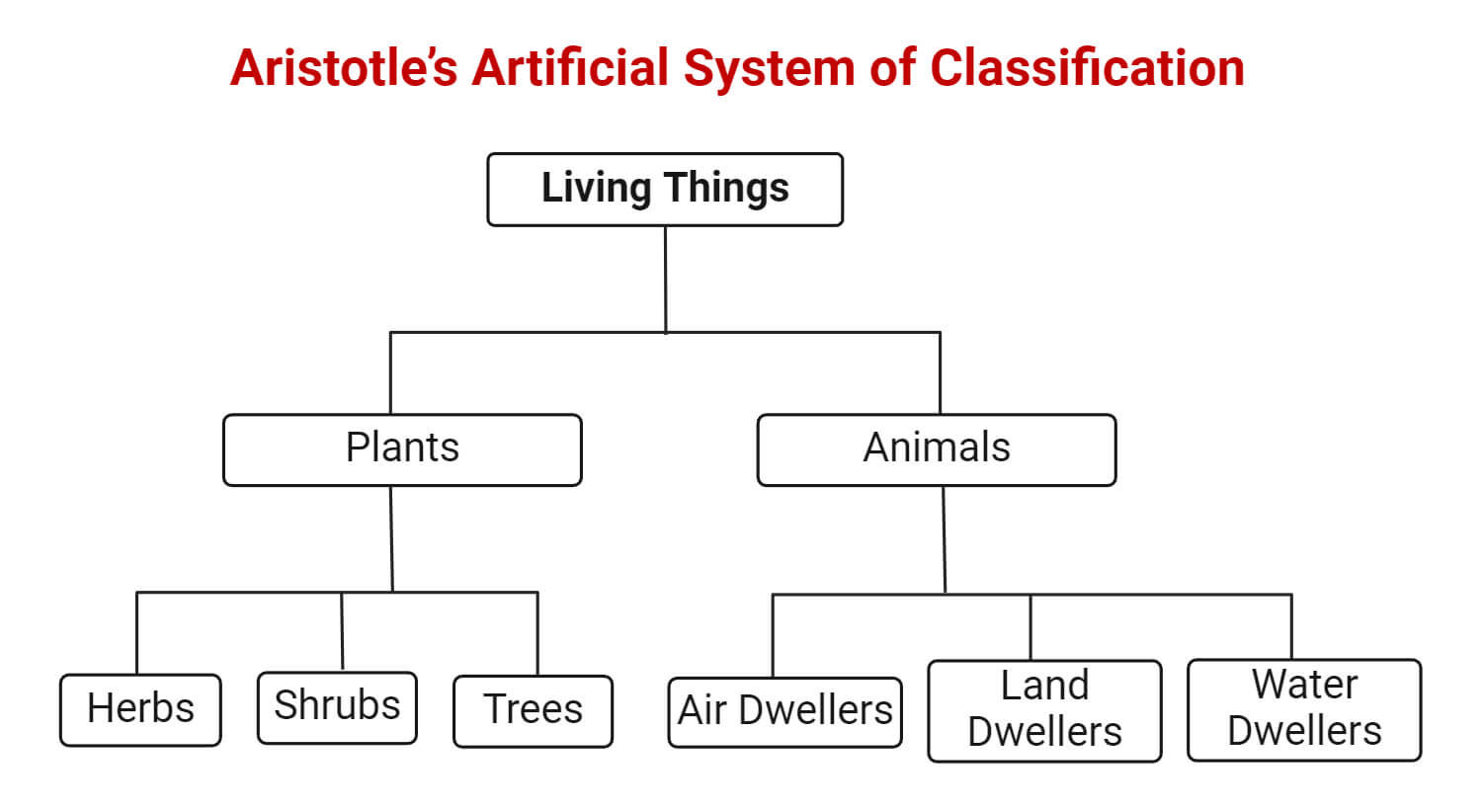
Following Aristotle’s classification, thoughts on evolution were heavily influenced by religion. It was believed that God created all life on earth. New species hadn’t appeared nor did the existing species extinct then. All aspects of nature were still considered as fixed and change was inconceivable. During this period, Jean-Baptiste Lamarck, a French biologist, proposed a theory called ‘Lamarckism’, also known as the theory of inheritance of acquired characteristics. This theory hypothesizes that organisms can change their characteristics throughout their lifetime in response to environmental changes, and these new characteristics can be passed to their offspring. An example of this theory is how the existence of giraffes came to be. According to Lamarck, giraffes evolved their long necks while trying to consume the leaves of tall plants and this trait continued to pass through generations. Lamarck is the first to theorize that change is natural.
These ideas were around for years until Charles Darwin proposed his theory of the origin of species that states living beings evolve with time through natural selection and only the fittest survive.
After Darwin’s contribution, Carolus Linnaeus, the father of taxonomy, introduced the binomial nomenclature system and laid the early groundwork for modern nomenclature systems. Organisms were given two names: genus and species, based on characteristics. He classified organisms into three kingdoms: Regnum Vegetabile (Plant Kingdom), Regnum Animale (Animal Kingdom), and Regnum Lapideum (Mineral Kingdom). He further classified plants into 24 phyla, based on the reproductive structures i.e. the number of stamens and the number of pistils. Animals were divided into 6 classes: Mammals, Aves, Amphibians, Pisces, Insecta, and Vermes. Minerals were divided into 4 classes namely Petrae, Minerae, Fossilia, and Vitamentra. The Linnaeus System of Classification is another example of an artificial system of classification.
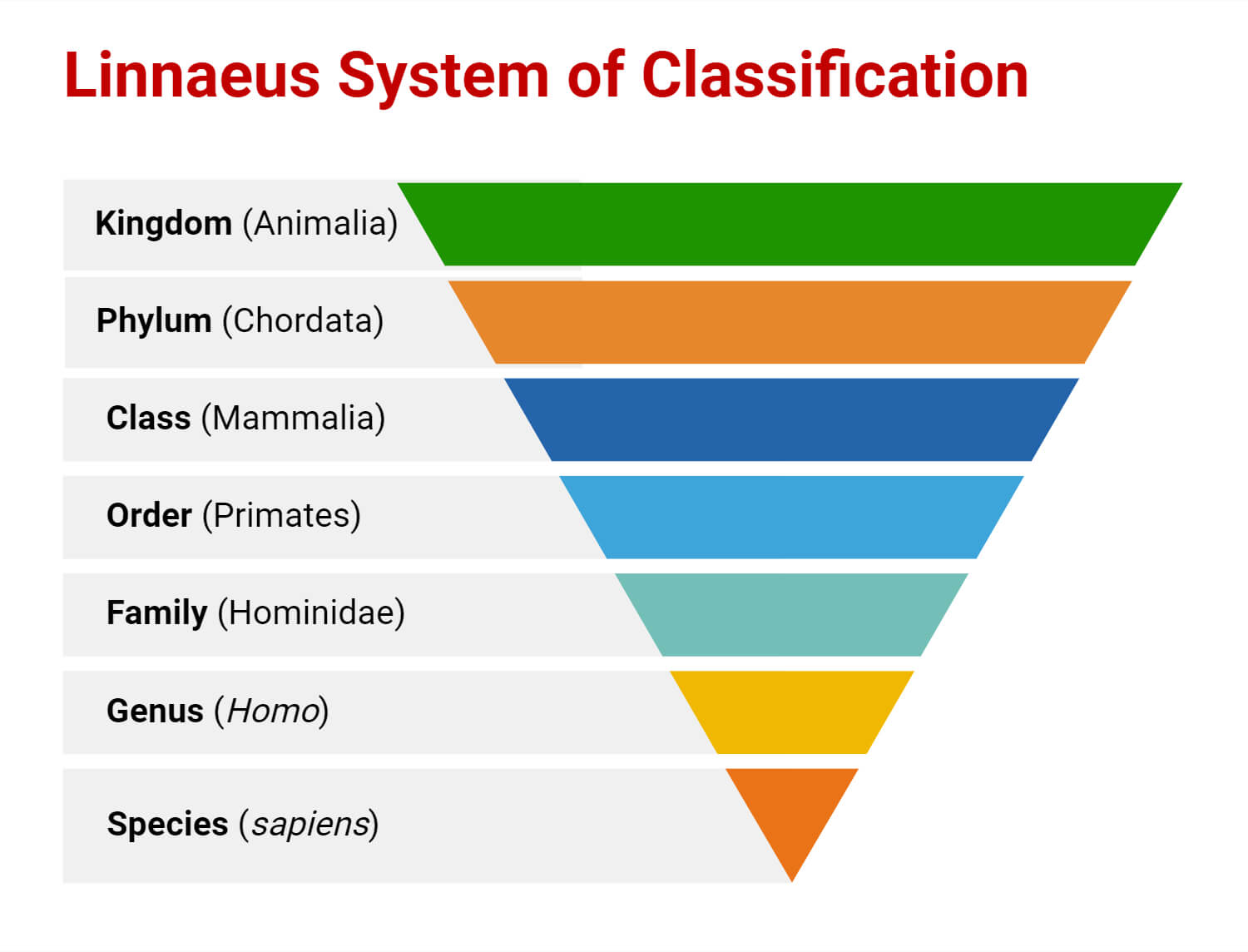
2. Natural System of Classification
This classification system includes differentiation of species based on similarities in morphology, genetics between species as well as evolutionary relationships. It accounts for physical traits as well as their genetic makeup so it is a well-rounded system of classification.
The Swiss botanist, Augustin Pyramus de Candolle, proposed his theory for plant classification. Candolle also introduced the term ‘taxonomy’, the first natural classification system. De Candolle made significant contributions to taxonomy and refined hierarchical ranks. He was the first to state the Ranalian group (Rhynia) as the primitive group. Along with that, he included descriptive identification of species. For instance, he arranged plants according to the arrangement of petals: polypetalous, gamopetalous, and apetalous.
Bentham and Hooker’s Natural System of Classification
Bentham and Hooker’s Natural System of Classification was a significant advancement in the field of taxonomy. British Botanists George Bentham and Joseph Dalton Hooker proposed this theory based on the principle of natural affinities and are considered pre-Darwinian as it doesn’t account for evolutionary affinities. They organized species based on their reproductive organs, types of seeds, and vascular systems. These scientists created the nomenclature system before the botanical nomenclature system existed.
The classification of plants according to Bentham and Hooker’s Natural System of Classification is as follows:
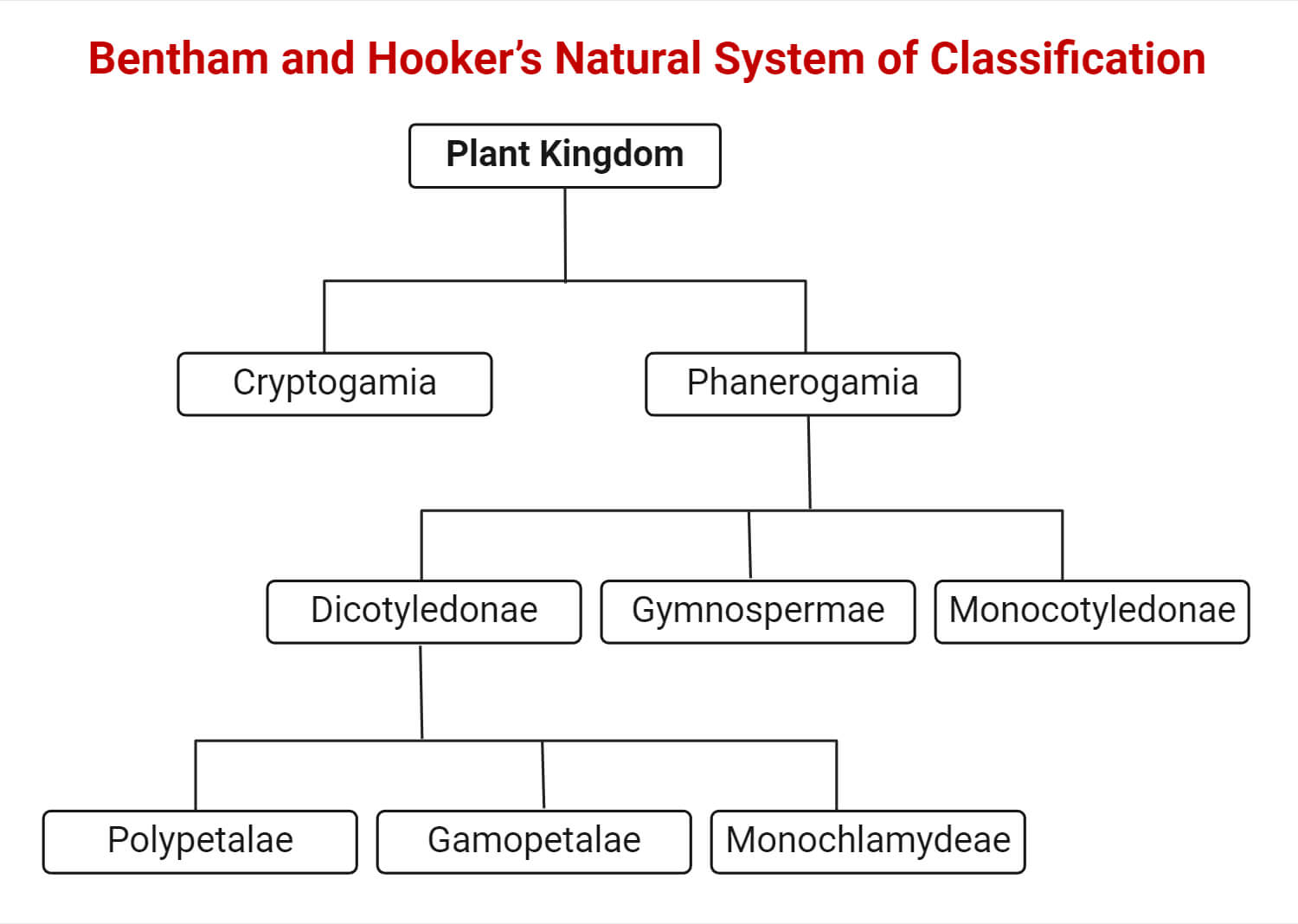
These British scientists divided Kingdom Plantae into two groups; Cryptogams and Phanerogams. Cryptogams are also known as non-flowering plants, they typically don’t produce seeds or flowers. Plants like ferns, mosses, etc are considered cryptogams. Phanerogams are also called flowering plants and they reproduce by seeds. They are further divided into three classes: Dicotyledonae, Gymnospermae, and Monocotyledonae. Dicotyledonae consists of two cotyledons in the seed, Gymnospermae consists of plants where the seed isn’t enclosed in fruit, and Monocotyledonae consists of a single cotyledon in the seed. Dicotyledonae is further divided into three subclasses: Polypetalae, Gamopetalae, and Monochlamydae.
Bentham and Hooker’s classification has both pros and cons, some of which are discussed below.
The merits of Bentham and Hooker’s classification are:
- Bentham and Hooker observed a wide number of species; 97,205 species and classified them into 202 families.
- This classification system is the most natural system based on examination of species.
- The description of plants is accurate and reliable.
- This classification system shows affinity to the modern concept of evolution. For instance, Rhynia (order Ranales) is the first order in the modern classification system. Ranales is the most primitive living angiosperm.
- The occurrence of Monocotyledon after Dicotyledon aligns with the modern classification system.
- This system of classification is used as a key to identify plants in the key herbarium.
The demerits of Bentham and Hooker’s Natural System of Classification are:
- The placement of Gymnosperm between Dicotyledon and Monocotyledon is inaccurate.
- One of the advanced families (Orchidaceae) was considered primitive according to Bentham and Hooker’s classification which is incorrect.
- Closely related families have been placed apart rather than next to each other in this classification.
3. Phylogenetic System of Classification
The phylogenetic system of classification is a modern approach to taxonomy. It includes the organization of species based on their evolutionary relationships rather than superficial characteristics. Groups of organisms are formed if they share similar evolutionary traits and origins. This classification system is reliable and provides an excellent framework for understanding living beings.
Engler and Prantl System of Classification
The German botanists Heinrich Gustav Adolf Engler and Karl Anton Eugen Prantl developed a new phylogenetic classification system called Engler and Prantl classification. These botanists followed the work of Bentham and Hooker and like them, the Engler-Prantl system provides details of the taxonomic system. This organized system is also understood as a post-Darwinian classification system; thus, it helps in understanding the history of species. Plants are arranged from an evolutionary standpoint and this is one of the reasons it differs from previous classification systems. Engler and Prantl considered monocotyledons as a primitive group hence, their classification starts with Monocotyledons.
The classification of plants according to Engler and Prantl System of Classification is as follows:
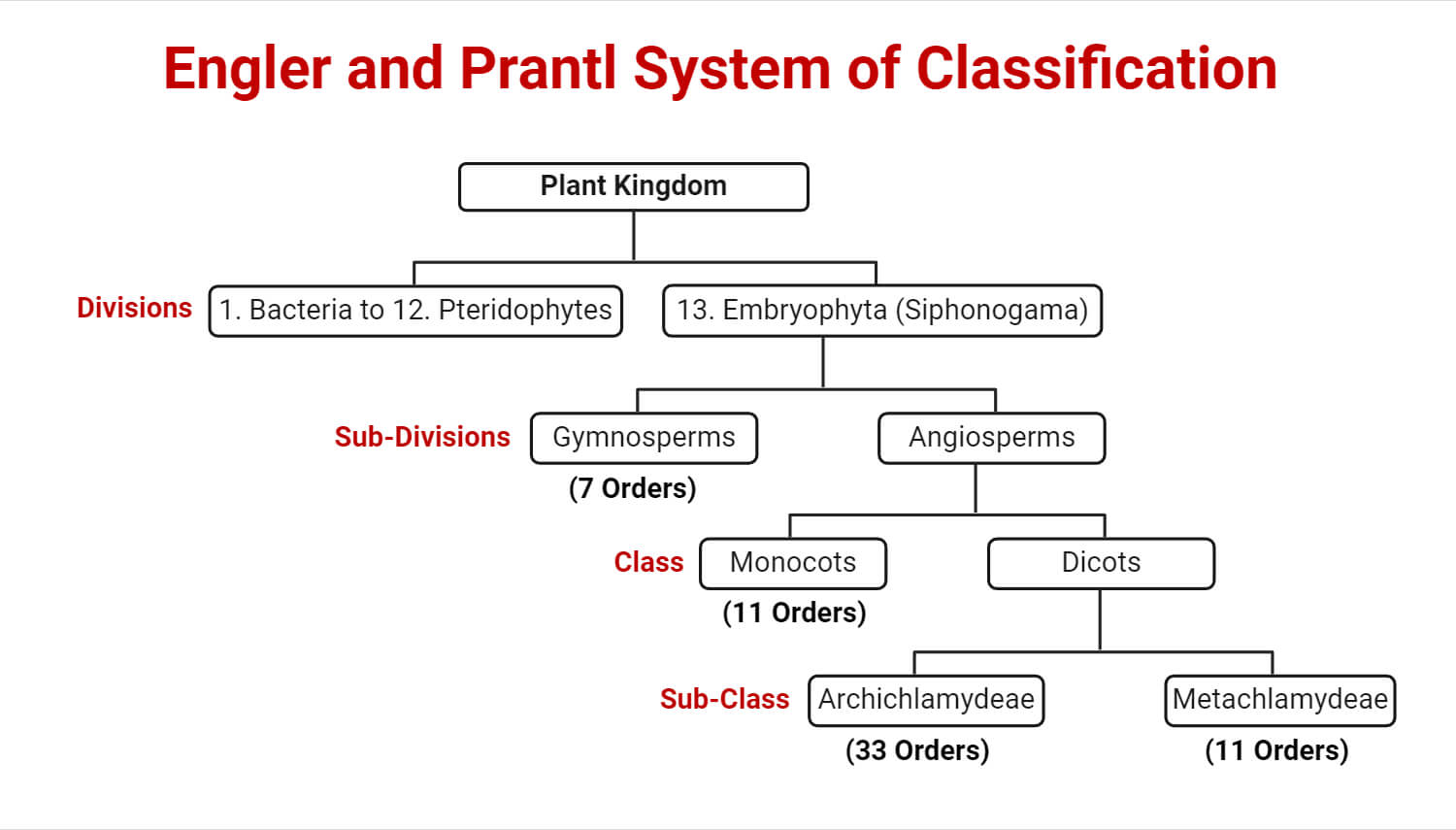
This classification system divides plants into 13 major divisions where the first 12 divisions include microorganisms, bryophytes, and pteridophytes, and the thirteen division includes Embryophyta (Gymnosperms and Angiosperms).
Gymnosperms are divided into 7 orders from Cycadofilicales (fossil gymnosperms) to Gnetales (advanced gymnosperms).
Angiosperm is further divided into Monocots and Dicots.
Monocots are divided into 11 orders where naked unisexual flowers are included in Pandanales with the family Typhaceae.
Dicot is classified as Archichlamydeae (primitive plants, with basic and simple floral arrangements) and Metachlamydeae (advanced plants with well-developed floral structures).
Archichlamydeae consists of polypetalous plants where the first order is Verticillatae with the family Casuarinaceae and the last order is Umbelliflorae with the family Cornaceae.
Metachlamydeae consists of gamopetalous plants.
The merits of the Engler and Prantl classification system are:
- Engler and Prantl’s classification is a phylogenetic system that deals with evolutionary affinities.
- This classification system provides modern taxonomic keys for the identification of each group of plants.
- Engler and Prantl have dealt with all groups of the Plant Kingdom; Bacteria, Algae, Fungi, Bryophyta, Pteridophyta, Gymnosperm, and Angiosperm.
- Gymnosperm is acknowledged as a different group that is cohesive with modern understandings.
- The position of Gymnosperms before Angiosperm is accurate.
- The position of Asteraceae (Compositae) as the last family of Dicotyledons is accurate.
- The position of Orchidaceae at the end of Monocots is accurate.
The demerits of the Engler and Prantl classification system are:
- Monocots are considered more primitive than Dicots which is inaccurate.
- Unisexual achlamydeous flowers were considered primitive. This concept needs to be revised.
Hutchinson’s System of Classification
Hutchinson’s System of Classification is another phylogenetic system of plant classification that was proposed by John Hutchinson, a British botanist. This classification is sometimes called contemporary classification, reflecting a modern approach developed in the early 20th century. Hutchinson considers Gymnosperms to be more primitive than Angiosperms. He also classified based on the principle that trees and shrubs are more primitive than climbers. Dioecious and unisexual flowers are considered advanced and bisexual and monoecious flowers are considered as an old trait.
Hutchinson classified Angiosperms into Dicots and Monocots, Dicots into Lignosae(woody plants) and Herbaceae(non-woody plants), and Monocots into Calyciferae(flowers that have distinct calyx and corolla), Corolliferae(plants with similar calyx and corolla), and Glumiflorae (plants with lodicules as outer organ).
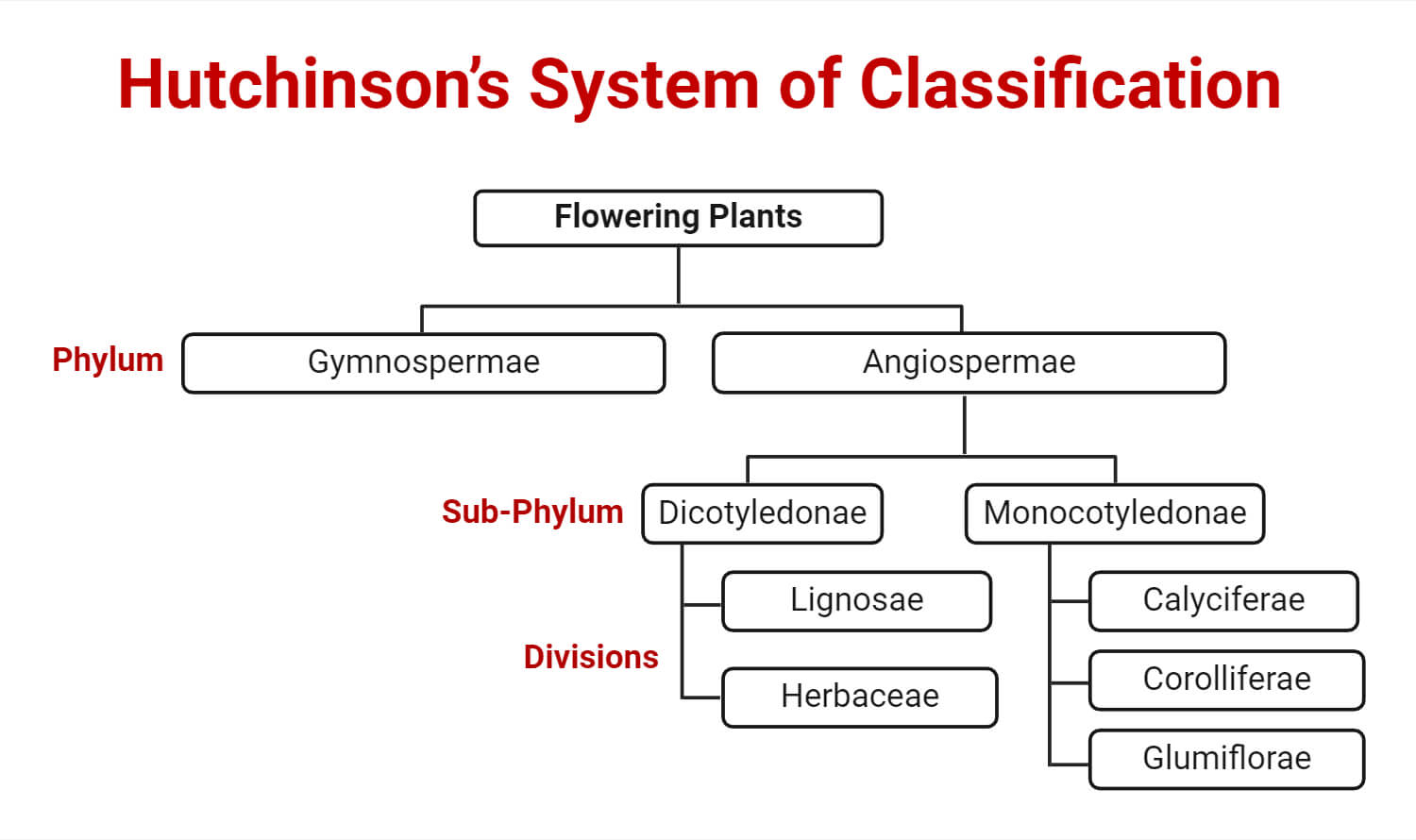
Cronquist System of Classification
Cronquist System of Classification was developed by an American biologist, Arthur John Cronquist and it is a widely used classification system. It is based in phylogenetic principles and also called contemporary classification in terms of it’s relevance as it showcases the best relationship of flowering plants.
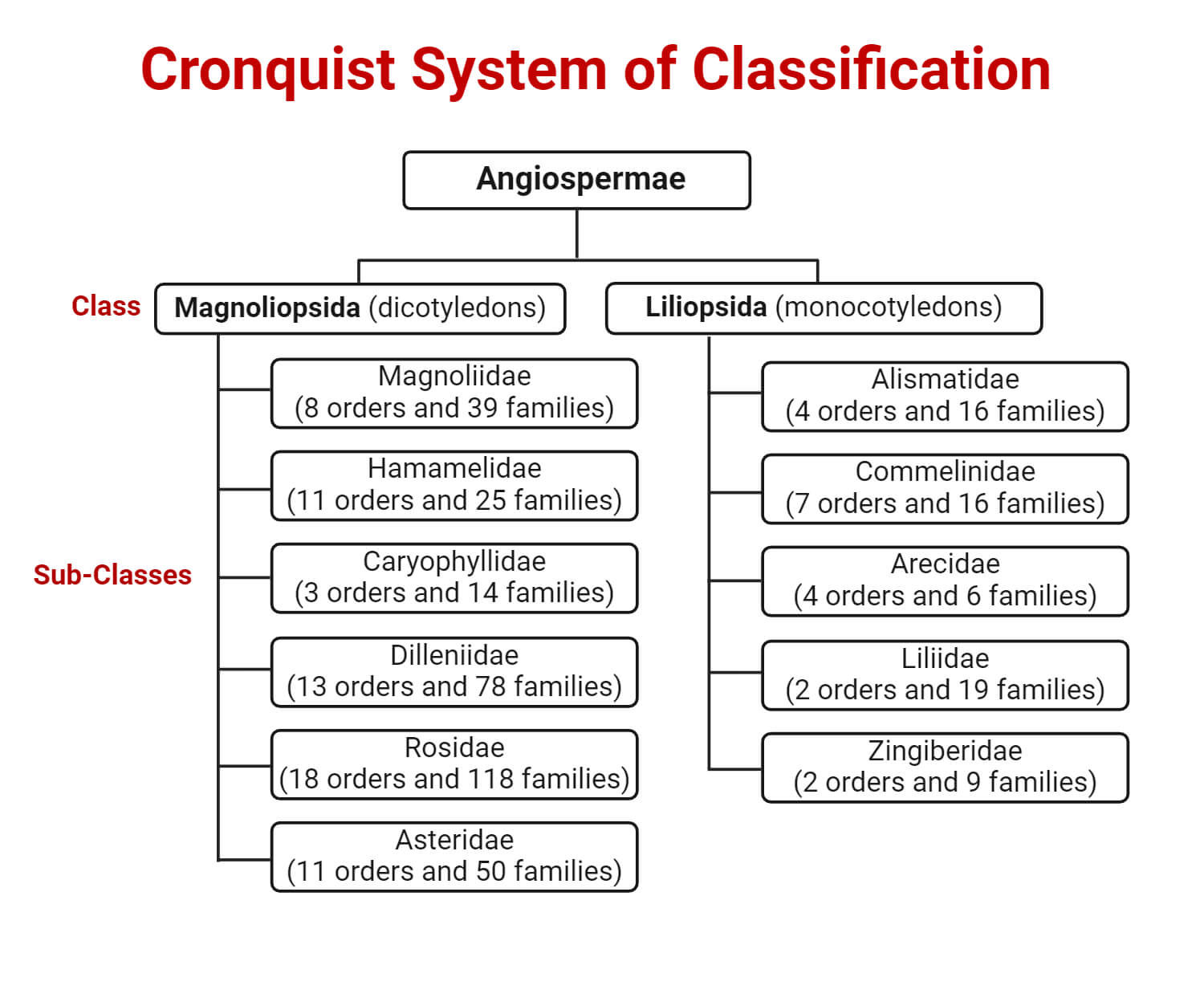
Cronquist divided angiosperms into Magnoliopsida (Dicotyledons) and Liliopsida (Monocotyledons). Magnoliopsida is further organized into 6 subclasses from Magnollidae to Asteridae, and Liliopsida is further organized into 5 subclasses from Alismatidae to Lillidae. This classification system is one of the firsts tp consider pteridosperm as the probable ancestors of angiosperms.
Angiosperm Phylogeny Group (APG) is a group of botanists from all around the world who work together to establish a set of organized reference for angiosperm classification. It started out as an informal group of researches from major institutions in the late 1990s. The objective of this group was to provide a widely accepted and more stable point of reference for plant classification. This group dissolved the traditional concept of dividing flowering plants into monocotyledons and dicotyledons. APG doesn’t include extinct species in it’s classification but it covers a lot of the over 295,000 angiosperm species found worldwide.
References
- Secretariat of the Convention on Biological Diversity. (n.d.). What is Taxonomy? Retrieved from https://www.cbd.int/gti/taxonomy.shtml
- https://adpcollege.ac.in/online/attendence/classnotes/files/1626680718.pdf
- https://www.shivajicollege.ac.in/sPanel/uploads/econtent/9ab8759378b1544a8fe9098e5da09528.pdf
- https://www.davuniversity.org/images/files/study-material/book%20on%20taxonomy.pdf
- https://dspmuranchi.ac.in/pdf/Blog/classification-Part1.pdf
- Müller-Wille S. Systems and How Linnaeus Looked at Them in Retrospect. Ann Sci. 2013;70(3):305-317. doi:10.1080/00033790.2013.783109
- Notes on biological classification. (2022, April 21). Retrieved from https://unacademy.com/content/upsc/study-material/general-science/biological-classification/
- Lefèvre, W. (2001). Natural or Artificial Systems?. In: Lefèvre, W. (eds) Between Leibniz, Newton, and Kant. Boston Studies in the Philosophy and History of Science, vol 220. Springer, Dordrecht. https://doi.org/10.1007/978-94-015-9729-6_10
- https://www.govtwomencollegeslm8.org/e_content/Botany/III%20B.Sc%20Morphology%20&%20Taxonomy%20of%20angiosperms/English/Unit%201-5/angiosperm%20phylogeny%20group.pdf

Excellent, it is an interesting work and hardworking which gives self esteems to learners who are in touched to higher education or detailed subjectmatters.